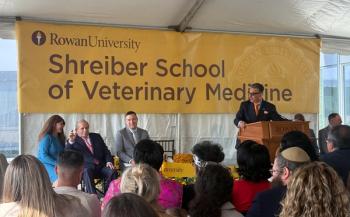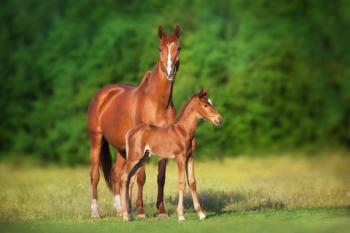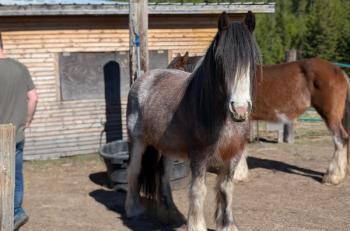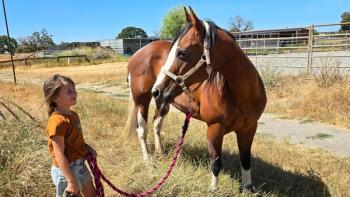
The trouble with Friesians
With a recent spike in popularity-and more than 100 years of tight inbreeding-these horses are developing serious breed-specific conditions.
With its jet-black coat, powerful frame and signature high-stepping gait, the Friesian horse has become increasingly popular over the past 20 years. A Friesian named Othello played the prominent role of the stallion Goliath in the 1985 film Ladyhawke. Friesians have increasingly been favorites of Hollywood with roles in Conan the Barbarian, Eragon, The Mask of Zorro, Alexander, The Chronicles of Narnia, Clash of the Titans and The Hunger Games. This familiarity and growing popularity mean that practitioners are likely to see even more Friesian horses in their practices.
A purebred population leads to problems
The Friesian breed originated in the Netherlands and is thought to have come from primitive forest horses native to that land. Many experts think that during the 16th and 17th centuries, some Andalusian blood was added to the developing Friesian breed, although little direct documentation of that exists. These horses were strong and heavy enough to carry a knight in armor but were more graceful and athletic than heavier draft breeds of that time.
With their distinctive look, Friesian horses have increasingly been favorites of Hollywood and also popular with horse owners. But inbreeding has led to many abnormalities equine practitioners should be on the lookout for. (GETTY IMAGES / ERIC ISSELTE)
Despite centuries of breed development, the Friesian studbook wasn't started until 1879. But this particular type of horse has been purebred since that time. For well over 100 years, Friesians have been tightly inbred.
With their recent popularity leading to greater demand and increased breeding with restricted bloodlines, Friesian horses are facing some significant problems that all practitioners should be familiar with. A number of suspected genetic disorders affect the Friesian horse. Identifying these problems early will aid clinicians in prompt, accurate treatment and, equally importantly, will possibly help remove these animals from breeding programs. This may be the single best step toward eliminating these problems from the breed.
Roughly 7 percent of the Netherlands' horse population is Friesians. So it's no surprise that from 1995 to 2003, 7 percent of the caseload at Utrecht University's College of Veterinary Medicine in the Netherlands and Ghent University's College of Veterinary Medicine in Belgium was composed of Friesian horses.1 What was surprising, however, was that veterinarians at these two schools began to notice a high incidence of certain clinical problems among Friesian horses—much higher than the 7 percent population should predict. Researchers from these institutions have subsequently joined with a number of private clinics in these countries and are now trying to document problems in Friesians and educate veterinarians worldwide about these conditions.
Dwarfism
One of the best-known disorders in the Friesian breed is dwarfism. The condition manifests with growth retardation mainly in the limbs, which are 25 percent shorter than normal. A Friesian dwarf is about 50 percent smaller than an age-matched normal Friesian foal.1 This condition is easily observed because of the larger head, broad chest and disproportionately long back with short limbs.
Hyperflexion of the fetlocks and narrow, long-toed hooves are also seen in these animals. Tendon and ligament laxity varies greatly between dwarf Friesians and normal ponies, with dwarfs showing excessive looseness to these structures and, often, resultant load failure. Normal Friesians have tendon and ligament stretch properties in between those of dwarfs and normal ponies.2 Some researchers think the Friesians' increased laxity is what creates their characteristic high-stepping, dancing gait. Many of the problems currently being investigated in the Friesian breed also stem from abnormalities in ligaments, or, more specifically, from a systemic collagen-linked disorder. It would be ironic if the condition that allowed the Friesian breed to exhibit its signature movement were also shown to be behind many of the devastating problems that threaten this breed.
The Friesian registry is no longer allowed to breed dwarves, and hopefully this problem will eventually disappear. But because this condition was tolerated and dwarves were still used as broodmares until relatively recently, dwarfism is likely to remain a part of the breed's genetics for some time.
Hydrocephalus
Hydrocephalus is a relatively uncommon disorder in horses, but in Friesians it is seen at an estimated rate of 2.5 foals per 1,000 births.1 Some researchers think the higher incidence of hydrocephalus in this breed is caused by a deformation of the jugular foramen. If this collagen-based structure fails to develop properly, a chain of events begins that may lead to fatal hydrocephalus. A nonfunctional jugular foramen could lead to internal jugular vein compression. This could disturb cerebral spinal fluid and enhance its accumulation, resulting in hydrocephalus.1 In an article documenting Friesian clinical issues, Siebren Boerma, DVM, of the Equine Clinic Garijp in the Netherlands and colleagues discuss both dwarfism and hydrocephalus and attempt to connect them genetically.1
Megaesophagus
One of the most serious clinical problems seen in the Friesian breed is megaesophagus. This problem is directly related to the suspected collagen abnormality seen in this breed.1 Megaesophagus is a chronic dilation of the esophagus, accompanied by a lack of normal muscle tone and contractile ability in the esophageal wall. It can be seen in all animals but is usually found at a very low rate in the general horse population.
In a study conducted between 2002 and 2007 by Boerma along with Marianne Sloet van Oldruitenborgh-Oosterbaan, DVM, PhD, DECEIM, of Utrecht University's Department of Equine Sciences, 45 cases of megaesophagus were recorded.3 These cases were seen at either the Equine Clinic Garijp or Utrecht University. Of these 45 cases, 41 were Friesians, and the lead researchers noted a familial predisposition among affected horses, strongly suggesting that this condition may be hereditary.
Horses with megaesophagus show a variety of progressive clinical signs, including loss of appetite, salivation, muscle wasting, mild colic and esophageal obstruction or choke. Radiography with contrast material or direct visualization via endoscopy can identify the swollen, semifunctional esophagus and confirm the diagnosis. Chronic megaesophagus often leads to aspiration pneumonia, which can be expensive to treat and may ultimately lead to fatal complications in the horse. These horses can occasionally be managed, and some do well. But the far better method of dealing with megaesophagus in Friesian horses is to identify animals affected with this condition and remove them and related family members from any future consideration as breeding animals.
Compromised immunity
Friesian horses are thought to have weakened immune systems, so many problems that affect other horse breeds only marginally tend to be worse in this breed. For example, the incidence of retained placenta is nearly 54 percent in Friesian horses compared with only 2 to 10 percent in the general equine population.1
Insect bite hypersensitivity (excessive skin response to the bite from various seasonal insects, predominantly no-see-ems, or Culicoides species4) occurs in 18 percent of Friesian horses, as reported in one study.1 This hypersensitivity is an intense pruritic response commonly leading to hair loss (often extensive) and skin damage of the mane, tail, head and ventral abdomen (Photos 1 and 2). In many individuals, this skin damage is severe enough to render the horse unusable for prolonged periods (weeks to months) during the summer fly season. Comparatively, insect bite hypersensitivity occurred in only 8 percent of the Shetland pony population studied in the Netherlands.1 It is now thought that this Friesian condition is a familial disease with a polygenetic background. Affected animals can be treated with traditional methods, including medicated baths and topicals, insect control and repellant, corticosteroids and allergy desensitization, antihistamines and anti-inflammatory drugs. Friesians with this condition will often show a response to treatment, but recurrence is likely.
Photos 1 and 2: The caudal aspect of the left forelimb of a Friesian mare showing an area of poor hair growth, scabs and irritated skin. This area of caudal alopecia and roughened skin is located slightly higher than in most Friesians but shows the typical dry, flaky, rough appearance seen in these horses. Allergic reaction and insect bite hypersensitivity are two of the main causes of these lesions. (PHOTOS COURTESY OF DR. KEN MARCELLA)
Verrucous pastern dermatopathy
This condition is also overrepresented in the Friesian breed as well as several other draught horse breeds. This chronic dermatitis develops into thick, nodular, ulcerated skin on the caudal side of the pasterns. The long hair or feathering found in this location is thought to accumulate moisture and debris, which may have some role in the development of skin irritation. This condition has also been called chronic progressive lymphedema, grapes, greasy heel and granulomatous pastern dermatitis. These lesions are often frustratingly unresponsive to treatment. And although genetics is suspected of playing a role with this skin condition in the Friesian, it hasn't been proven.1
Aortic artery rupture
Aortic rupture is an important and unique problem in the Friesian horse that again relates to a disorder in collagen tissue.1 Just about all equine aortic ruptures in non-Friesian breeds occur at the connection between the aorta and the heart in an area called the aortic root. Rupture of the main blood vessel in the body at this level leads to rapid filling of the pericardial sac and cardiac tapenade as the blood-filled sac around the heart does not allow the heart to expand and beat. This condition leads to acute heart failure and death. Most horses suffering aortic rupture are either found dead with little to no sign of struggle or discomfort before death or are stable one moment and die very rapidly once the aorta ruptures.
In Friesians, however, the site of aortic rupture is at the aortic arch near the ligamentum arteriosum. Because the rupture occurs here in a more forgiving location in the heart, a number of scenarios can potentially develop that are unique to the Friesian horse. Also, because aortic ruptures in Friesian horses only appear to occur in this unique location, a genetic or, at the very least, breed-specific condition is considered likely.
If the aortic rupture is large, within seconds, the chest cavity is pumped full of blood, and the horse dies acutely. This is rare in Friesians. More often the tear may be smaller, so the blood leaks into the tissue surrounding the aorta, forming a perivascular pressure cuff. This pressure stops the bleeding, and these horses can remain stable for long periods. Because the heart must still pump blood through an aorta that is under pressure from the tissue swelling around it, an increased heart beat results even at rest. These horses often show poor performance, high heart rate and bounding pulses, intermittent lameness and swelling through the chest and ventral abdomen. Eventually the pressure cuff will not hold and the aorta will rupture completely, leading to death.
In some Friesians the rupture creates an aortopulmonary fistula, or an artificial connection between the damaged aorta and the pulmonary blood vessels. In this scenario, the lungs slowly begin to receive a larger than normal volume of blood. This can create a problem, as horses can go weeks to months before the lungs can no longer handle the increased blood flow from the aorta. Affected horses will develop a dry, hacking cough; poor performance; swelling of the chest and legs; fluctuating fever; pale mucous membranes; recurrent colic and intermittent lameness. Catherine Delesalle, DVM, PhD, DECEIM, of Ghent University urges that "because Friesian horses show suspicious clinical signs sometimes weeks to months before fatal rupture, these 'predictive signs' need to be put in the spotlight for the Friesian horse owners."5,6 Clinicians can also benefit by considering these signs and these breed-specific problems when dealing with Friesian horses.
The average age of horses with aortic rupture is 4 years old, so keep in mind that many of these horses will have been bred before developing this problem. Increased awareness and better, earlier diagnosis might be the best way to remove these horses from breeding consideration and the best way to eliminate these important conditions from the breed.
Dr. Ken Marcella is an equine practitioner in Canton, Ga.
References
1. Boerma S, Back W, Sloet van Oldruitenborgh-Oosterbaan MM. The Friesian horse breed: a clinical challenge to the equine veterinarian? Equine Vet Educ 2012;24(2):66-71.
2. Gussekloo SWS, Lankester J, Kersten W, et al. Effect of differences in tendon properties on functionality of the passive stay apparatus in horses. Am J Vet Res 2001;72:474-483.
3. Boerma S, Sloet van Oldruitenborgh-Oosterbaan MM. Megaoesophagus in the Friesian horse: a hereditary problem? in Proceedings. International Congress of World Equine Veterinary Association, 2008;484.
4. van Grevenhof EM, Ducro B, Heuven HCM, et al. Identification of environmental factors affecting the prevalence of insect bite hypersensitivity in Shetland ponies and Friesian horses in The Netherlands. Equine Vet J 2007;39:69-73.
5. van Loon G, De Clercq D, de Bruijn CM, et al. Aortic rupture and aortopulmonary fistulation: increased prevalence in Friesian horses and importance of early ante-mortem diagnosis, in Proceedings. Journées annuelles de l'Association Vétérinaire Equine Française, 2011;192-193.
6. Ploeg M, Saey V, de Bruijn CM, et al. Aortic rupture in Friesian horses: 3 scenarios revealed. Phyrso 2012.
Newsletter
From exam room tips to practice management insights, get trusted veterinary news delivered straight to your inbox—subscribe to dvm360.






